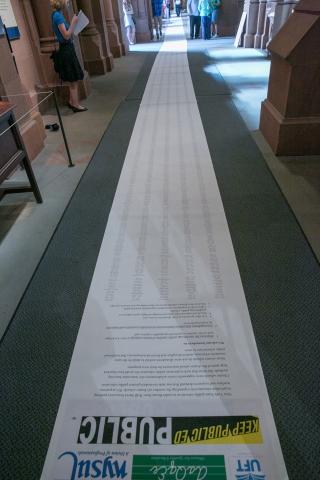Despite a $13 million advertising campaign, hedge-fund executives were unable to engineer the passage of an education tax credit for wealthy donors or an increase in the statewide charter cap in the state legislative session that wrapped up on June 25.
“We began the session in January with Gov. Cuomo attacking teachers and public education. The state Legislature adjourned without passing the toxic proposals that the governor had pushed,” UFT President Michael Mulgrew said in an email message to members.
Mulgrew credited educators and other public school advocates with fending off Cuomo and his allies in the Republican-led Senate.
Once known for his political deal-making skills, the governor failed to win on his signature education initiatives. Two of the infamous “three men in a room” were new, following the indictments of both former Assembly and Senate leaders on federal corruption charges. And Cuomo sank in the polls as he concentrated his efforts on undermining Mayor Bill de Blasio’s progressive agenda.
The governor personally campaigned for an education tax credit that would have given wealthy donors up to $1 million off their taxes for donating to private schools, but it was a non-starter in the state Assembly. Instead, nonpublic schools were given $250 million over the next two years to cover prior unpaid claims for mandated services such as transportation.
Cuomo also put his political weight behind a proposal that would have paved the way for up to another 250 charter schools in New York City. In the end, the state cap remains the same and the final deal limits the city to 50 additional charters: 24 that already had the green light to open; 22 from charter schools that closed and can now be reused; and four reassigned from upstate.
Charter schools will now be allowed to have up to 15 uncertified teachers (five of whom must be teachers of science, technology, or career and technical education subjects), up from five now. Charters still will not be required to admit high-needs students and English language learners at comparable percentages to district schools.
As a result of heavy lobbying by NYSUT, the UFT and parent groups, the State Education Department will now be required to release test questions and provide test results sooner to parents and teachers. A content review committee — including classroom teachers and experienced educators — will review questions before they are included in any test to make sure they are grade-level appropriate. Confidentiality agreements on revealing test questions were scaled back. And the Legislature’s final deal will also cut down the time that public school students spend taking standardized tests by reducing the field testing of potential test questions.
The Legislature agreed to only a one-year extension of mayoral control of schools in New York City, a reflection of the governor’s animus toward the mayor, who had campaigned for a permanent extension. However, the state Legislature did not agree to state oversight of the city’s education budget, as Senate Republicans had wanted.
The Legislature also failed to take action to curtail abuses in the East Ramapo School District, where private-school interests dominate the school board and have directed funds away from the public schools.
A Siena poll released on July 15 found that the governor’s statewide approval rating had dipped below 50 percent for the first time since 2007. Among New York City voters, his strongest base of support, his favorability dropped from 71 percent last October to 57 percent in July.
